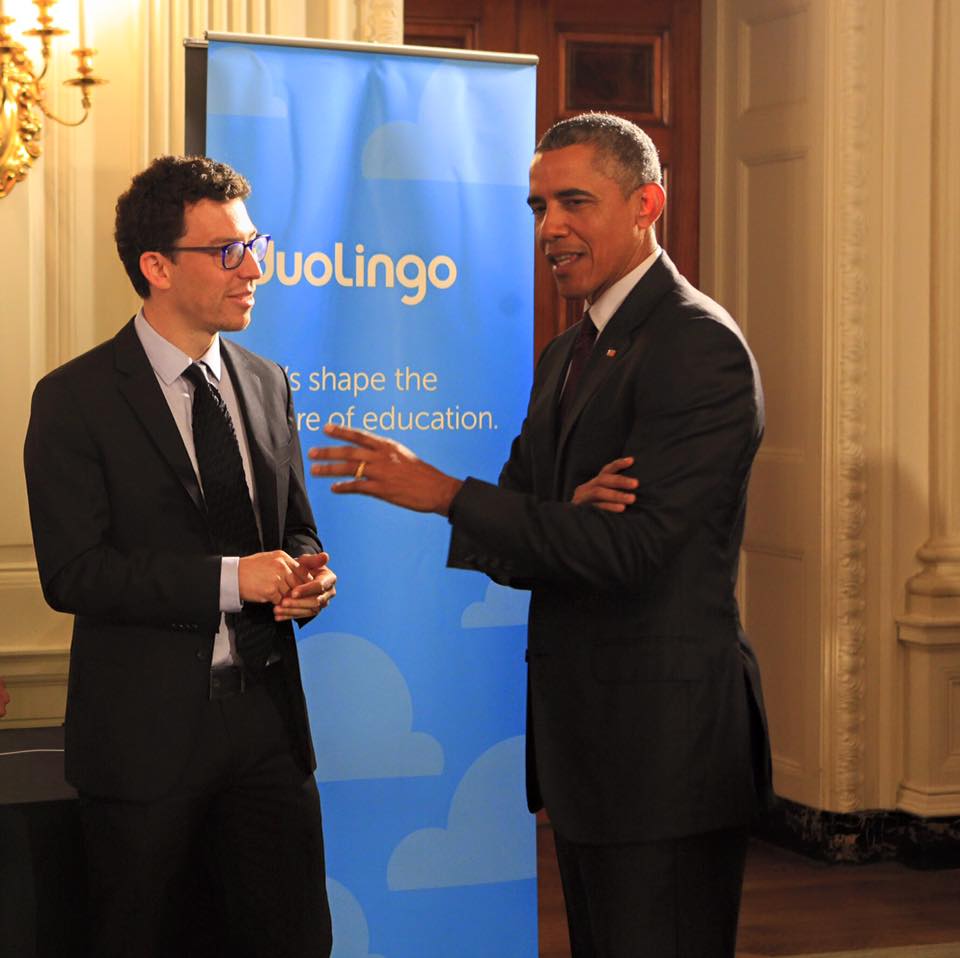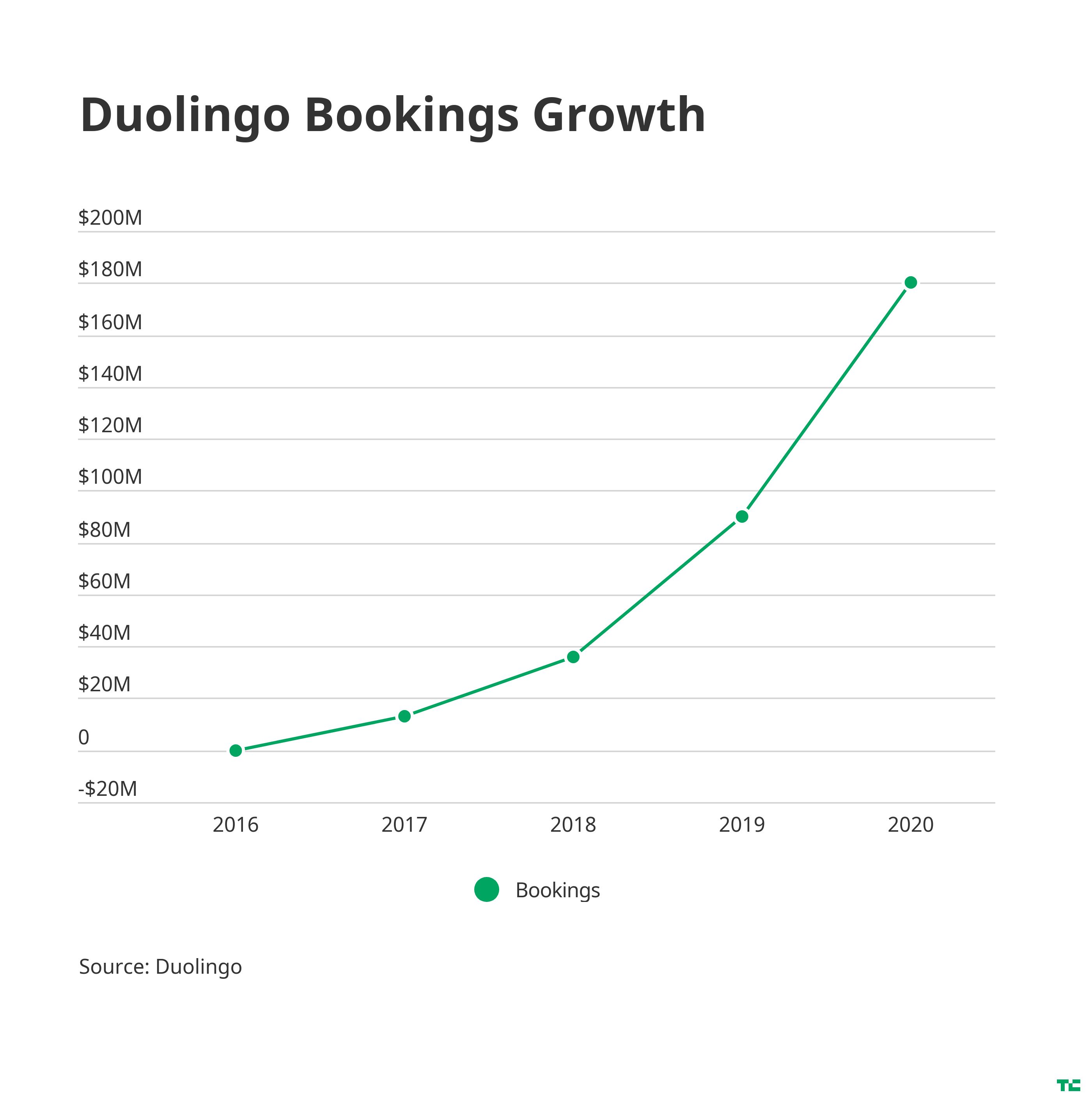babbel
Auto Added by WPeMatico
Auto Added by WPeMatico
Duolingo has been wildly successful. It has pulled in 500 million total registered learners, 40 million active users, 1.5 million premium subscribers and $190 million in booked revenues in 2020. It has a popular and meme-ified mascot in the form of the owl Duo, a creative and engaging product, and ambitious plans for expansion.There’s just one key question in the midst of all those milestones: Does anyone actually learn a language using Duolingo?
“Language is first and foremost a social, relational phenomenon,” said Sébastien Dubreil, a teaching professor at Carnegie Mellon University. “It is something that allows people to make meaning and talk to each other and conduct the business of living — and when you do this, you use a tone of different kinds of resources that are not packaged in the vocabulary and grammar.”
Duolingo CEO and co-founder Luis von Ahn estimates that Duolingo’s upcoming product developments will get users from zero to a knowledge job in a different language within the next two to three years. But for now, he is honest about the limits of the platform today.
“I won’t say that with Duolingo, you can start from zero and make your English as good as mine,” he said. “That’s not true. But that’s also not true with learning a language in a university, that’s not true with buying books, that’s not true with any other app.”

Luis von Ahn, the co-founder of Duolingo, visiting President Obama in 2015. Image Credits: Duolingo
While Dubreil doesn’t think Duolingo can teach someone to speak a language, he does think it has taught consistency — a hard nut to crack in edtech. “What Duolingo does is to potentially entice students to do things you cannot pay them enough time to actually do, which is to spend time in that textbook and reinforce vocabulary and the grammar,” he said.
That’s been the key focus for the company since the beginning. “I said this when we started Duolingo and I still really strongly believe it: The hardest thing about learning a language is staying motivated,” von Ahn said, comparing it to how people approach exercise: it’s hard to stay motivated, but a little motion a day goes a long way.
With an enviable lead in its category, Duolingo wants to bring the quality and effectiveness of its curriculum on par with the quality of its product and branding. With growth and monetization secured, Duolingo is no longer in survival mode. Instead, it’s in study mode.
In this final part, we will explore how Duolingo is using a variety of strategies, from rewriting its courses to what it dubs Operation Birdbrain, to become a more effective learning tool, all while balancing the need to keep the growth and monetization engines stoked while en route to an IPO.

Duolingo’s office decor. Image Credits: Duolingo
Duolingo’s competitors see the app’s massive gamification and solitary experience as inherently contradictory with high-quality language education. Busuu and Babbel, two subscription-based competitors in the market, both focus on users talking in real time to native speakers.
Bernhard Niesner, the co-founder and CEO of Busuu, which was founded in 2008, sees Duolingo as an entry-level tool that can help users migrate to its human-interactive service. “If you want to be fluent, Duolingo needs innovation,” Niesner said. “And that’s where we come in: We all believe that you should not be learning a language just by yourself, but [ … ] together, which is our vision.” Busuu has more than 90 million users worldwide.
Duolingo has been the subject of a number of efficacy studies over the years. One of its most positive reports, from September 2020, showed that its Spanish and French courses teach the equivalent of four U.S. university semesters in half the time.
Babbel, which has sold over 10 million subscriptions to its language-learning service, cast doubt on the power of these findings. Christian Hillemeyer, who heads PR for the startup, pointed out that Duolingo only tested for reading and writing efficacy — not for speaking proficiency, even though that is a key part of language learning. He described Duolingo as “just a funny game that is maybe not as bad as Candy Crush.”
One of the ironic legacies of Duolingo’s evolution is that for years it outsourced much of the creation of its education curriculum to volunteers. It’s a legacy the company is still trying to rectify.
The year after its founding, Duolingo launched its Language Incubator in 2013. Similar to its original translation service, the company wanted to leverage crowdsourcing to invent and refine new language courses. Volunteers — at least at first — were seen as a scrappy way to bring new material to the growing Duolingo community and more than 1,000 volunteers have helped bring new language courses to the app.
Powered by WPeMatico
Fluent Forever, a startup that uses a novel learning system to help its users master a new language faster, has raised a $4.9 million funding round led by Denver-based Stout Street Capital. Other investors in this round include The Syndicate, LAUNCH, Mana Ventures, Noveus VC, Flight.VC, Insta VC, UpVentures, Firebrand Ventures, Cultivation Capital, Spero Ventures and Lofty Ventures.
In many ways, Fluent Forever is a direct competitor to Duolingo, Babbel and similar online language learning services. What sets it apart is a focus on a personalized learning system that emphasizes ear training, visual aids and something akin to spaced-repetition for helping you memorize new words and phrases. It’s a paid service (after a 14-day free trial) with subscriptions starting at $10 per month for a monthly subscription and the usual discounts for longer-term commitments.
To teach himself his first languages, the company’s founder and CEO Gabriel Wyner used the popular flashcard service Anki, wrote a book about his approach, and taught workshops on language learning using his system with Anki. But as he noted, Anki is a serious tool, and simply learning how to get the most out of it takes a lot of time and energy.
“I’ve watched everyone else fail at language learning,” he told me. “And the first thought is, okay, well, if you just learn how to do it right, then that’s a fixable thing. That’s exciting. And then once you have a solution for people and they’re all excited about it — but then you watch them fail because of IT reasons. That’s extra frustrating.”
In many ways then, Fluent Forever uses Wyner’s flashcard approach — because building those flashcards by hand is at the core of his learning system — and turns it into a far-easier-to-use application.
What people want, Wyner acknowledged, is a tool where you just press some buttons and learn something. But that doesn’t work. “I had to have a really strong reaction to this — a really strong answer — and say, ‘absolutely not. That is the one thing that teaches you is building it.’ ”
Wyner is not afraid to compare his approach to Duolingo’s and argues that its focus on translation exercises doesn’t translate to real language skills in the long run. At the same time, he freely acknowledges that the Duolingo user experience and gamification are far better than Fluent Forever. But he also believes that learners see far better results with his system.
“We ask [our users]: ‘Why are you with us? Why would you pay for us when you could just get Duolingo for free?” What they come back with is, ‘yeah, your product is rough around the edges. I wish you would fix this, this and that, but you had me thinking in Spanish in two weeks,” Wyner said.
Fluent Forever currently supports nine languages: Japanese, French, Russian, Mexican and Spanish Spanish, Italian, Korean, German and Brazilian Portuguese, with Dutch being the next language the team is tackling.
As Wyner told me, the company had trouble raising in 2019, in part because the service was seeing pretty flat growth at the time. “People are very skeptical about language learning — that is not a sexy field. People don’t like it. The idea of jumping and trying to be competitive with Duolingo was just not appealing to anyone,” he told me. Come 2020, though, growth picked up, even before the COVID pandemic. At the same time, Fluent Forever also participated in Jason Calacanis’ Launch Accelerator.
Looking ahead, Wyner tells me that Fluent Forever is looking at ways to bring live tutors into the loop. Live tutoring online has been done before, of course, and there are some companies like Preply that specialize in it already, but what Fluent Forever wants to do is combine the online language learning service with short live sessions and then use the online component to go back to that conversation over the course of a week or so. One advantage here is that these users — who will likely pay a premium for the live service — will also use their time with live tutors to create their own personalized sentences in the Fluent Forever system, which could then over time become content that’s available to all users, too.
Powered by WPeMatico
Language learning apps, like many educational technology platforms, soared when millions of students went home in response to safety concerns from the coronavirus pandemic. It makes sense: Everyone became an online learner in some capacity, and for non-frontline workers, each day became an opportunity to squeeze in a new skill (beyond sourdough).
So why not learn a new language in a low-lift way?
Language learning platforms, including Babbel, Drops and Duolingo, all have benefitted from quarantine boredom as shown by surges in their usage. However, success also depends on whether these same companies can turn that primetime interest into dollars and profit.
To figure out if the language learning boom comes with paying customers, I caught up with Luis von Ahn, the CEO of Duolingo, a popular language learning company valued at $1.5 billion.
Von Ahn tells TechCrunch that Duolingo has hit 42 million monthly active users, up from 30 million in December 2019. The surge comes as new users are spending more time on the app in aggregate, for some of the reasons explained above. Duolingo has been steadily increasing in bookings over the past few years:

This year, Duolingo will hit $180 million in bookings, von Ahn estimates. The company discloses bookings as a proxy for revenue, because when someone purchases a subscription the app it is considered a “booking” until the completion of the subscription, when it becomes revenue.
“We’re more than breaking even,” von Ahn told TechCrunch.
While this growth is impressive, the most staggering metric that von Ahn revealed is that $180 million in bookings is only coming from 3% of its current users.
“Only 3% of our users pay us, yet we make more money than the apps where 100% of their users pay them,” he said.
Powered by WPeMatico
The latest startup to see an uplift in inbound interest flowing from the remote work boom triggered by the coronavirus pandemic is Berlin-based Everphone, which sells a “mobile as a service” device rental package that caters to businesses needing to kit staff out with mobile hardware plus associated support.
Everphone is announcing a €34 million Series B funding round today, led by new investor signals Venture Capital. Other new investors joining the round include German carrier Deutsche Telekom — investing via its strategic investment fund, Telekom Innovation Pool — U.S.-based early-stage VC AlleyCorp and Dutch bank NIBC.
The Series B financing will go on expanding to meet rising demand, with the startup telling TechCrunch it’s expecting to see a 70-100% increase in sales volume versus the pre-crisis period, thanks to a doubling of inbound leads during the pandemic.
“The global pandemic has been a catalyst for growth in the field of digitization,” said CEO and co-founder, Jan Dzulko, in a statement. “We are currently experiencing a significant increase in demand at home and abroad, which is why we are aiming for European expansion with the funding.”
Everphone describes its offer as a one-stop shop, with the service covering not just the rental of (new or refurbished) smartphones and tablets but an administration and management wrapper that covers support needs, including handling repairs/replacements — with the promise of replacements within 24 hours if needed and less client risk from not having to wrangle traditional rental insurance fine print.
Other touted pluses of its “device as a service” approach include flexibility (users get to choose from a range of iOS and Android devices); lower cost (pricing depends on customer size, device choice and rental term but starts at €7,99 a month for a refurbished budget device, rising up to €49,99 a month for high-end kit with a 12-month upgrade); and rental bundles, which can include standard mobile device management software (such as Cortado and AirWatch) so customers can plug the rental hardware into their existing IT policies and processes.
Everphone reckons this service wrapper — which can also extend to include paid apps (such as Babbel for language learning) as an employee on-device perk/benefit in the bundle — differentiates its offer versus incumbent leasing providers, such as CHG-Meridian or De Lage Landen, and from wholesale distributors.
It also touts its global rollout capability as a customer draw, checking the scalability box.
Its investors (including German carrier, DT) are being fired up by the conviction that the COVID-19-induced shift away from the office to home working will create a boom in demand for well-managed and secured work phones to mitigate the risk of personal devices and personal data mingling improperly with work stuff. (On that front, Everphone’s website is replete with references to Europe’s data protection framework, GDPR, repurposed as scare marketing.)
“Everphone envisions that every employee will one day work via their smartphone,” added Marcus Polke, partner at signals Venture Capital, in a supporting statement. “With this employee-centric approach and integrated platform, everphone goes far beyond the mere outsourcing of a smartphone IT infrastructure.”
The 2016-founded startup has more than 400 customers signed up at this point, both SMEs and multinationals such as Ernst & Young. It caters to both ends of the market with an off-the-shelf package and self-service device management portal that’s intended for SMEs of between 100 and 1,500 employees — plus custom integrations for larger entities of up to 30,000 employees.
It says it’s able to offer “highly competitive” prices for renting new devices because it gives returned kit a second life, refurbishing and reselling devices on the consumer market. “Thanks to this profitable secondary lifespan, we are able to offer highly competitive prices and extensive service levels on our rental devices,” Everphone writes on its website.
The second-hand smartphone market has also been seeing regional growth. Swappie, a European e-commerce startup that sells refurbished iPhones, aligning with EU lawmakers’ push for a “‘right to repair” for electronics, raised its own ~$40 million Series B only last month, for example. Its second-hand marketplace is one potential outlet for Everphone’s rented and returned iPhones.
Powered by WPeMatico
The slow and steady rise of Babbel has been impressive on many fronts. The company is now managing the top-grossing language learning app in the world. That’s why I’m excited to announce that we’ll have founder and CEO Markus Witte as well as CEO U.S. Julie Hansen at TechCrunch Disrupt Berlin.
Babbel has been around for over a decade. The company started with a web-based language learning service. It was based on Adobe Flash and HTML. Now, most Babbel users interact with the service using the company’s mobile app.
And Babbel also represents a European success story. Thanks to the European Union, many people live, work and travel all around Europe. It creates a unique market opportunity as the continent is a highly fragmented market when it comes to languages — there are dozens of different languages. That’s why building a language learning startup in Berlin is the perfect fit.
Babbel operates with a freemium, subscription-based model. Downloading the app is free, but you need to pay a subscription to unlock all the features.
More recently, Babbel has been betting on the U.S. as its next market opportunity. Many Europeans want to learn English, and it’s also true in the U.S. Immigrants want to improve their knowledge of English.
It’s a different market that causes a different set of challenges. That’s why the company has named Julie Hansen as CEO of the U.S. division of Babbel.
If you want to hear both Hansen and Witte talk about Babbel’s past ten years and the company’s next ten years, you should come to Disrupt Berlin.
Buy your ticket to Disrupt Berlin to listen to this discussion and many others. The conference will take place on November 29-30.
In addition to fireside chats and panels, like this one, new startups will participate in the Startup Battlefield Europe to win the highly coveted Battlefield cup.
Babbel Founder and CEO
Markus Witte is CEO and founder of Babbel , the world’s top-grossing language learning app. He describes Babbel as a learning company inside and out: “Heading a team in which each and every person, as well as the organization itself, is constantly learning new things is incredibly fulfilling.”
Markus began his career at NYU, and later lectured at Humboldt University in Berlin, where he discovered his passion for teaching. Following his time as an academic, he led the development of online marketing and web infrastructure and managed the online and systems teams at music software company Native Instruments. Coming back to learning and teaching, he founded Babbel with three others in 2007.
Babbel CEO U.S.
Julie Hansen is CEO U.S. at Babbel. Based in the company’s New York office she is leading the US expansion of the world’s top-grossing language learning app.
Before joining Babbel, Julie was the COO and President of Business Insider. Under her leadership the news site became the most visited business outlet on the internet. Prior to Business Insider, Hansen held top management roles at sports site NCAA.com, Condé Nast Publications, and Time Inc. Julie has over two decades of experience growing digital media companies, launching interactive web sites, deploying mobile apps, and leading online and offline marketing campaigns. She began her career at Penguin Books, publishing learning software for literature among other products.
Powered by WPeMatico
There are plenty of choices out there if you want to learn a new language, but if you’re in Europe, chances are you’ve given Babbel a shot. The app, which started back in 2007 on the web, is celebrating its 10th birthday by expanding to the U.S. — a unique country that has proven a unique challenge for the company and its model.
We chatted with Babbel’s Chief Strategy Officer and co-founder, Thomas Holl, at the company’s headquarters in Berlin. The success of the company was evident in the lively, populous workplace.
But although the app is the top-grossing language learning app in the world, it’s more than possible that many of our readers haven’t encountered it, since it started in Europe and until very recently has stayed there.
 It differs from other popular platforms like Duolingo, Holl explained, by focusing on real-world settings like introductions and restaurant interactions.
It differs from other popular platforms like Duolingo, Holl explained, by focusing on real-world settings like introductions and restaurant interactions.
“I think it’s very practical, and that’s probably the difference to many other solutions out there that have a rather structural approach — we’re always focused on language that you can actually use in real life.”
There’s also something unique about each pair of languages — that is to say, a Mandarin speaker has different challenges learning French than a Spanish speaker. So lessons and progression are specific to each pairing, not just copy-pasted and translated. Babbel touts this as a reason why people learn faster on its platform. (People may feel they need to get their money’s worth as well – it’s a subscription service.)
Expanding to the U.S. has been the company’s main ambition over the last year, but the U.S. is very unlike the tangle of closely-related, multilingual states on that side of the pond. Few people are looking to improve a second or third language in order to advance their careers, Holl pointed out, with a major exception: English learners.
 It shouldn’t surprise anyone that the most popular language to learn in the U.S. is English; we are a country of immigrants, after all, and although we have many communities that speak their native language at home, English is a necessity for getting by.
It shouldn’t surprise anyone that the most popular language to learn in the U.S. is English; we are a country of immigrants, after all, and although we have many communities that speak their native language at home, English is a necessity for getting by.
Babbel has deployed a new type of monolingual course for advanced English learners, essentially a story in English that you fill out as it goes along. The audio portion has the added difficulty of multiple English (and Scottish, and Liverpudlian) accents.
Combined with apps like Blue Canoe, which focuses on pronunciation, English learners are beginning to have a real wealth of resources online.
Powered by WPeMatico
 Language learning service Babbel is one of Berlin’s quiet startup success stories. While it was once on the brink of shutting down, today it’s a thriving company with hundreds of employees who work in a sprawling office in the middle of Berlin — and it’s the market leader in large parts of Europe. Unlike competitors like Duolingo, though, Babbel is a paid service. Read More
Language learning service Babbel is one of Berlin’s quiet startup success stories. While it was once on the brink of shutting down, today it’s a thriving company with hundreds of employees who work in a sprawling office in the middle of Berlin — and it’s the market leader in large parts of Europe. Unlike competitors like Duolingo, though, Babbel is a paid service. Read More
Powered by WPeMatico